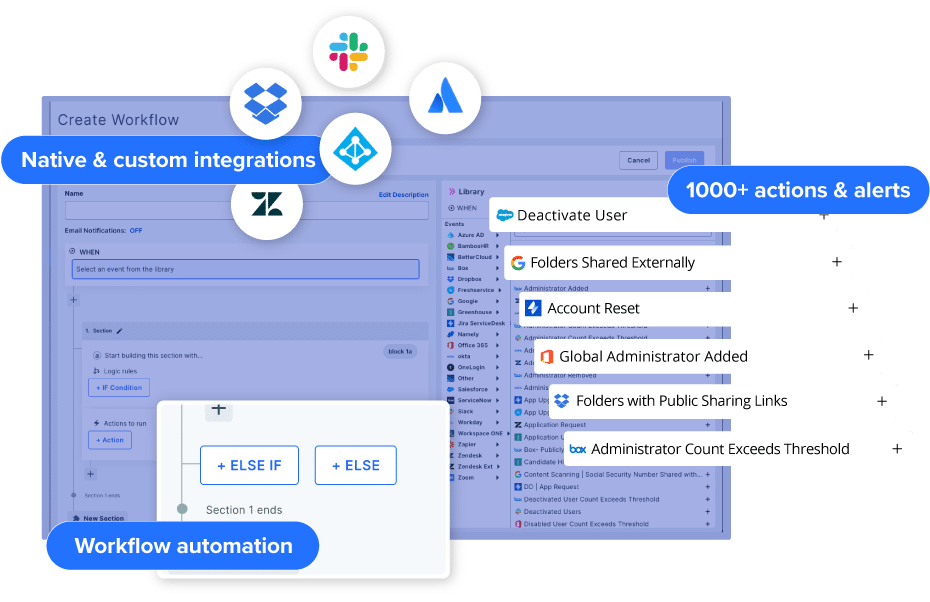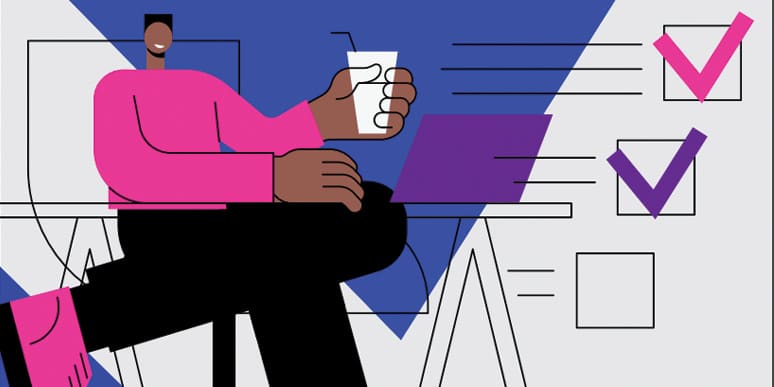What is SaaSOps?
Explore what SaaS operations management entails, who typically handles it, and how SaaSOps pros can benefit your organization.

SaaSOps is the practice of managing software-as-a-service (SaaS) applications through centralized and automated operations (Ops). This process includes everything from finding the right applications to purchasing them, managing them, and eventually canceling them if necessary.
SaaS operations management is typically implemented by an IT team, in which companies can benefit from reduced friction, improved collaboration, and better employee experience.
Why is SaaSOps important?
Cloud applications are the norm, but to keep them secure and efficient, structured management is key. A dedicated SaaSOps team provides the framework you need to keep your SaaS environment under control.
Here’s why SaaSOps is essential:
- Visibility and control into the full SaaS stack and redundant app purchases
- Streamlined user management
- Enhanced security
- Efficiency boost
- Cost optimization
By implementing SaaSOps, organizations gain the visibility, control, and efficiency needed to thrive in a cloud-driven world.
What are some of the IT roles related to SaaSOps?
As we rely more heavily on SaaS applications, IT professionals have expanded into specializing in SaaSOps. From SaaS administrators who handle day-to-day maintenance and user permissions, to security specialists who safeguard sensitive data, SaaSOps leaders ensure a smooth and secure SaaS experience for the organization.
The most popular job titles for IT professionals in SaaSOps include:
- SaaSOps architect
- SaaSOps manager
- SaaSOps engineer
- Security specialist
- IT procurement specialist
What are the main responsibilities of SaaSOps?
SaaSOps encompasses a comprehensive set of practices and responsibilities, but it’s core functionalities are:
- SaaS Discovery
- SaaS Management
- SaaS Governance
- SaaS Optimization
- SaaS Automation
SaaS Discovery
Imagine your organization’s technology as a toolbox. SaaS discovery is like taking inventory of every tool in that box, along with how everyone is using them. This includes both the official tools (sanctioned applications) and any unofficial ones that employees might have signed up for themselves (unsanctioned applications).
The problem is, adding unapproved tools can be as easy as a five-minute sign-up with a company credit card. This creates a situation known as shadow IT, which can lead to security risks and licensing problems.
The solution is complete visibility. By gaining a clear view of an organization’s SaaS environment, SaaSOps teams can establish a central process for finding and approving new tools. This fosters collaboration between different departments and IT, ensuring everyone’s needs are met while maintaining control over the entire set of SaaS tools.
SaaS Management
With dozens (or even hundreds) of SaaS subscriptions, maintaining control can feel overwhelming. From onboarding to mid-lifecycle changes to offboarding, user provisioning/deprovisioning and adjusting access all takes place.
Just imagine a world where onboarding a new employee or offboarding a departing one doesn’t involve a frantic scramble for individual app logins. SaaSOps streamlines this process, allowing app access management and workflow automation with ease.
SaaS Governance
SaaS governance establishes a foundational layer of control over your organization's cloud-based software. This includes robust reporting, alerting, and measurement tools to monitor the usage and security of your SaaS applications. It also dives deeper by assessing the comprehensiveness and functionality of integrations between your various SaaS apps and other essential tools.
By implementing SaaS governance, SaaSOps can ensure the smooth operation of the SaaS environment, mitigate security risks, and optimize the return on investment for these cloud-based tools.
SaaS Optimization
As SaaSOps manages the SaaS stack, they also are very close to the spend allotted to each application in the company techstack. This puts IT in a unique position to work closely with finance to truly optimize SaaS spend.
Getting the most out of your investment is crucial. SaaSOps facilitates an ongoing evaluation of your techstack to track underutilized applications, optimize license tiers, and leverage reporting tools to track user activity. Here’s where the true optimization comes in: by translating these insights into action.
SaaSOps can identify opportunities for license reclamation, such as purging inactive user accounts or renegotiating contracts based on lower usage data.
This collaboration between IT and finance ensures maximum value extractions for all of your SaaS subscriptions.
SaaS Automation
Let’s face it, manual tasks are time-consuming and error-prone, leading to security risks. SaaSOps embraces automation to free up your IT team’s bandwidth and allows them to focus on more strategic initiatives.
Common instances primed for automation include:
- User lifecycle management: Automate user provisioning, deprovisioning, and mid-lifecycle changes during offboarding, offboarding, and role changes. This eliminates manual data entry and ensures security by granting access only to authorized users and applications.
- Access requests: Implement automated workflows for access requests, with approvals routed to the appropriate managers. This streamlines the process and minimizes delays for employees who need access to critical applications, starting from day one.
- Active security enforcement: Proactively scan for security policy violations and take immediate action to prevent unwanted exposure.
The challenges SaaSOps addresses
SaaSOps tackles the challenges of a constantly evolving techstack head on, ensuring a smooth and secure SaaS ecosystem for your organization.
Here's how SaaSOps addresses key pain points:
- SaaS sprawl: Uncontrolled growth of SaaS subscriptions across departments creates a complex and often invisible IT landscape. SaaSOps tackles sprawl by implementing discovery tools and enforcing approval processes for new subscriptions.
- Shadow IT: Employees often resort to unauthorized cloud tools to address specific needs if IT-approved solutions are lacking. SaaSOps promotes a collaborative approach, identifying employee needs and offering sanctioned alternatives, reducing reliance on shadow IT and its inherent security risks.
- Cost optimization: Multiple subscriptions with overlapping functionalities and low employee app usage can lead to wasted spend. SaaSOps facilitates cost analysis, identifying underutilized applications and seat licenses and opportunities for volume discounts through vendor negotiations.
- Security risks: Unapproved SaaS tools and weak access controls expose sensitive data to breaches. (Not to mention forgetting to offboard a user) SaaSOps enforces security best practices, including centralized user management and data encryption, minimizing the attack surface and safeguarding company information.
By addressing these challenges, SaaSOps empowers businesses to leverage the full potential of their cloud applications while maintaining control, security, and cost-effectiveness.
What tool do you need to implement SaaSOps practices?
To be the most effective, SaaSOps engineers need an end-to-end SaaS management platform (SMP). A SMP gives IT everything they need to overcome the challenges of their organization’s techstack.
A SMP empowers SaaSOps engineers with:
- A centralized dashboard: A SMP is IT’s command center to see every application, every expense, and ever user.
- User lifecycle management automation: Manual user provisioning and deprovisioning across a vast SaaS landscape is a nightmare. Automatically onboard users with pre-configured permissions and access, adjust access levels when roles change within an organization, and offboard users by removing access to all SaaS applications upon departure.
- Enforce security policies: IT no longer has to be reactive, an end-to-end SMP allows for a proactive, automated response to predefined security policies that can be applied consistently across all SaaS apps.
- SaaS spend management: With a growing SaaS stack, costs can easily spiral out of control. Identify unused licenses, track contract trends, and cost allocation all in one place with a SMP with spend management.
BetterCloud: The platform made for SaaSOps professionals

In 2011, SMP leader and pioneer BetterCloud developed the world’s first SaaS management tool. Over the years, it’s expanded to manage multiple SaaS apps (2016), integrate with a wider ecosystem of tools (2019), and introduced no-code automation for orchestrated workflows in the early 2020s.
Then, in 2024, BetterCloud acquired G2 Track, the best-in-class SaaS spend management tool with unrivaled discovery, an employee app catalog, and license optimization according to usage, entitlements, and employee surveys.
With its complete range of functionality, BetterCloud is now the world’s first, and only end-to-end SaaS management platform. Paired with implementation services and support to ensure quick value add, SaaSOps pros are well-equipped to maximize the ROI for cloud-based applications.
Ready to dive in?
Specifically designed for IT, try our interactive demo or book a product tour to see why thousands of SaaSOps pros have chosen BetterCloud.


